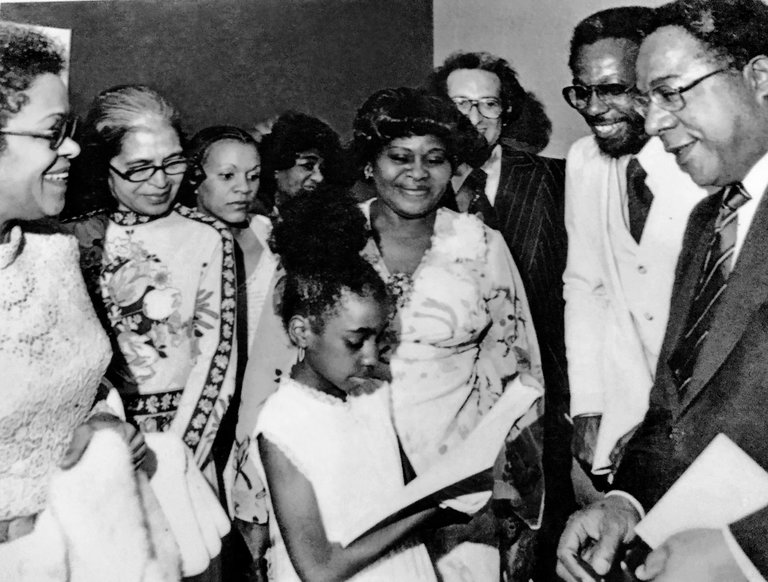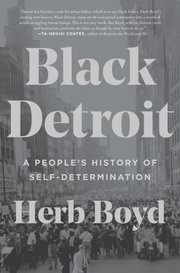
SEPT. 6, 2017
In Praise of the
Black Men and Women
Who Built Detroit

Herb Boyd, second from right, at Wayne State University in 1977, as his daughter reads to Alex Haley. Also in the group is Rosa Parks, second from left. Credit via Harper Collins
BLACK DETROIT
A People’s History of Self-Determination
By Herb Boyd
Illustrated. 416 pp. Amistad/HarperCollins Publishers. $27.99.
Detroit has found its griot in Herb Boyd. Traditional West African storytellers, griots carry their people’s traditions from generation to generation, and are renowned for their encyclopedic knowledge, their wit and their ability to bridge the past and present. In the tradition of the griot, Boyd has written a song of praise to what he calls “the city’s glorious history.”
In 29 chapters, spanning more than three centuries, Boyd offers an unusual retelling of Detroit’s past, with black voices on nearly every page. The arc of his narrative is a familiar one in which he traces the transformation of Detroit from a French trading outpost to the world’s automobile production center to a national symbol of urban decline and rebirth. Along the way, Boyd introduces us to some of Detroit’s key social movements: abolitionism, union organizing, civil rights and black power. But this book is not a conventional urban history. Boyd’s purpose is to celebrate the black men and women, the city’s “fearless freedom fighters,” who would otherwise remain on history’s margins.
The characters who walk across Boyd’s pages are fascinating. We get tantalizing glimpses of the lives of the several hundred enslaved Africans who lived in colonial Detroit, including William Kenny, who ran away but found the time to taunt his former master with a sarcastic letter. We follow the career of the Pelham brothers, Robert Jr. and Benjamin, who, in 1883, founded The Detroit Plaindealer, Detroit’s first black newspaper.

Later, we meet 20th-century black “breakthrough” figures, like Charles Diggs Sr., Detroit’s first black congressman and proprietor of the wonderfully named House of Diggs funeral parlor; George Crockett Jr., a crusading labor and civil rights lawyer and his wife, Ethelene Crockett, who was Michigan’s first African-American obstetrician; and Ed Davis, the country’s first black auto dealer. Sometimes, as with the Crocketts, Boyd sacrifices detail in his efforts to be comprehensive. We learn, for example, that George Crockett was jailed for subversion during the McCarthy era, but with little context to help understand the radical political world in Detroit that Crockett inhabited.
The heart of Boyd’s book spans the 1930s to the 1970s, when Detroit became America’s largest majority black city. Boyd arrived in Detroit — as did so many of the city’s residents — as part of the Great Migration of African-Americans to the North. They remade the city. While Boyd tends to focus mostly on the city’s black elites, including the Motown impresario Berry Gordy and Mayor Coleman Young (this book is decidedly a “people’s history” from the top down), his most effective and poignant passages introduce ordinary Detroiters. One of the most interesting is the author’s mother, Katherine Brown, who arrived in Detroit from the South in 1941 and, as Boyd puts it, “grew up with the city, rolled with its punches, and cheered its victories.” During the war, Brown worked in an electronics factory, part of “a veritable army” of black women in well-paying manufacturing jobs. But the wartime gains were short-lived. Returning veterans, mostly white, took back factory jobs; out-of-work, Brown returned to cooking and cleaning for pay. Brown appears again as one of the first black residents of her West Side neighborhood, a true act of self-determination and great risk in a city where whites fiercely resisted the first black neighbors who moved in.
Boyd’s narrative culminates in his account of black power in 1960s-era Detroit, perhaps because it is where his story and the city’s converge. As a faculty member at Wayne State University, a hotbed of black student activism, Boyd joined the successful push for the creation of an influential African-American studies program.
Nearly every current of black power played out in Detroit, and Boyd touches on them all. The Nation of Islam, founded in Detroit in the 1930s by the mysterious W.D. Fard, had a small but active presence in the city. Malcolm X spent a few formative years in the city and returned in 1963 to deliver one of his most famous speeches, “The Message From the Grassroots.” The Rev. Albert Cleage led the militant Shrine of the Black Madonna. Black autoworkers founded the Revolutionary Union Movement, beginning at Dodge Motor Company, demanding black power in the workplace. The Republic of New Afrika used its Detroit base to advocate for black self-determination. Detroit’s Broadside Press, led by the poet Dudley Randall, became a nationwide outlet for the black literati. And, by the early 1970s, for all of their differences, Detroit’s black activists found common cause in challenging police brutality and electing Coleman Young as the city’s first black mayor, controversial for his black-power-infused rhetoric but, in ways that Boyd doesn’t acknowledge, quite conventional in his embrace of mid-1970s downtown redevelopment and austerity politics.
Today Detroit, with vast sections of its 139 square miles lying in ruin, its black population moving in unprecedented numbers to inner-ring suburbs, its residents struggling with failing schools, joblessness and incarceration, is not a land of hope. Travel reporters highlight Detroit’s thriving art scene, trendy restaurants and influx of hipsters. But those changes have scarcely benefited the working-class and poor black Detroiters who make up more than 80 percent of the city’s residents. There are a lot of reasons to despair about the city’s future. But Boyd remains hopeful. “Throughout the history of Detroit, no matter the political strife, economic despair, and racial oppression,” he writes, black Detroiters “have been steadfast in their resolve and optimistic about the future.” That optimism is the Detroit tradition of which the griot sings.
+++++++++++
Thomas J. Sugrue, a native of Detroit, is the director of the American studies program at New York University and the author of “Sweet Land of Liberty: The Forgotten Struggle for Civil Rights in the North.
